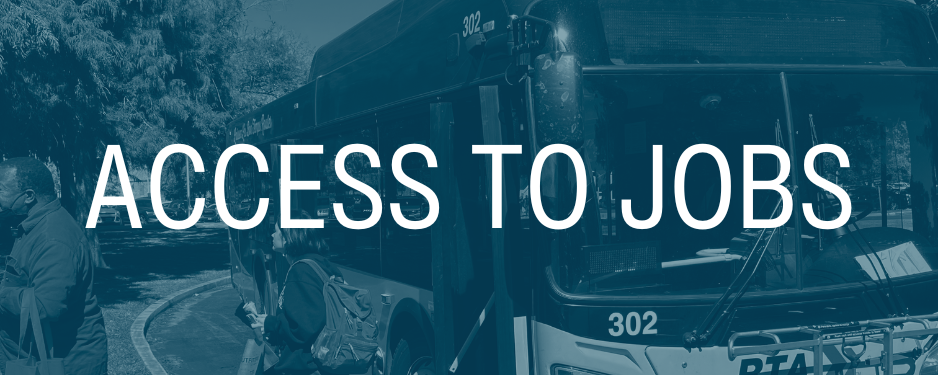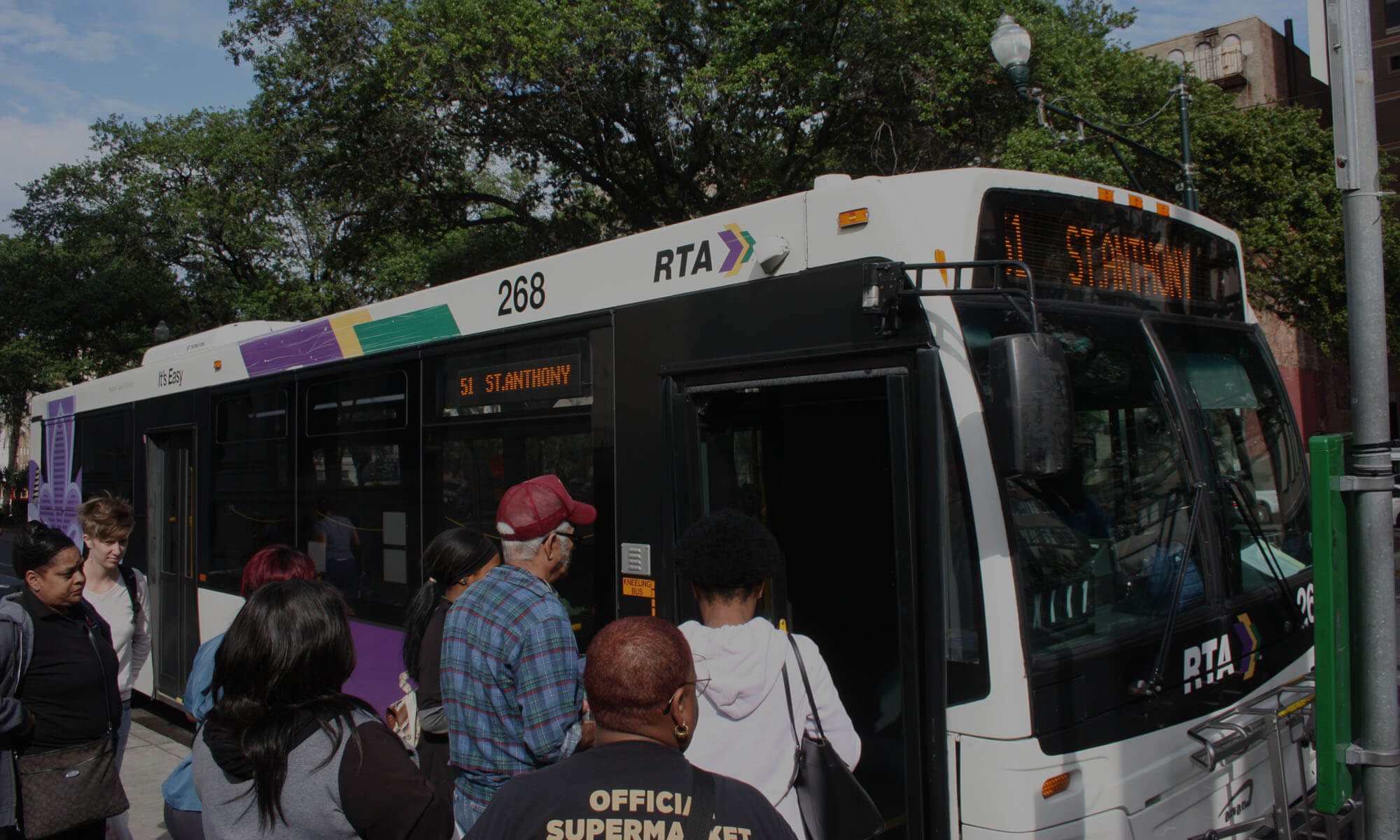
ACCESS TO JOBS
RETURN TO MAIN PAGE
Since 2016, RIDE has calculated and published annual metrics for the number of jobs accessible by transit for the typical worker living in Orleans, Jefferson, and St. Bernard Parishes. The purpose of this accessibility analysis is twofold: 1) to quantify and compare the number of jobs that can be accessed on public transit compared to driving by residents of each parish within a 60-minute threshold, and 2) to evaluate the impacts of changes to RTA and JP Transit service on job accessibility.
Access to jobs by block group
Data: 2025 Job Access
RTA GTFS Feed (2025): Download here. Feed version S1000239 for service effective September 7, 2025. Obtained from RTA website. As of 2024, the active RTA GTFS feed is maintained online and can be downloaded at norta.com/RTA/media/GTFS/GTFS.zip.
JP Transit GTFS Feed (2024): Download here. Feed version S1000174 for service effective June 15, 2025. Obtained from JP Transit staff. As of 2025, the JP Transit feed is not yet maintained online.
OpenStreetMap Roads (2023): Obtained from the Geofabrik dataset of archived OSM extracts. OpenStreetMap data as of 2023-01-01. download.geofabrik.de/north-america/us/louisiana.html
Census Bureau LEHD Origin-Destination Employment Statistics (LODES): Residence and workplace characteristics are from the LODES 8.3 release (published November 19, 2024). All LODES 8.3 data is enumerated using 2020 census blocks and block groups. lehd.ces.census.gov/data/
Residence data: 2022 Residence Area Characteristics (RAC) file for primary jobs for workers living in Louisiana (la_rac_S000_JT01).
Workplace data: 2022 Residence Area Characteristics (RAC) file for all private jobs for employees working in Louisiana (la_wac_S000_JT02).
Census geography shapefiles: 2020 census blocks and block groups obtained from 2020 TIGER/Line shapefile data. census.gov/geographies/mapping-files/time-series/geo/tiger-line-file.2020.html
Data: 2024 Job Access
RTA GTFS Feed (2024): Download here. Feed version S1000227 for service effective September 22, 2024. Obtained from RTA website. As of 2024, the active RTA GTFS feed is maintained online and can be downloaded at norta.com/RTA/media/GTFS/GTFS.zip.
JP Transit GTFS Feed (2024): Download here. Feed version S1000170 for service effective September 22, 2024. Obtained from JP Transit staff. As of 2024, the JP Transit feed is not yet maintained online.
OpenStreetMap Roads (2023): Obtained from the Geofabrik dataset of archived OSM extracts. OpenStreetMap data as of 2023-01-01. download.geofabrik.de/north-america/us/louisiana.html
Census Bureau LEHD Origin-Destination Employment Statistics (LODES): Residence and workplace characteristics are from the LODES 8.0 release (published April 4, 2023). All LODES 8.0 data is enumerated using 2020 census blocks and block groups. lehd.ces.census.gov/data/
Residence data: 2019 Residence Area Characteristics (RAC) file for primary jobs for workers living in Louisiana (la_rac_S000_JT01).
Workplace data: 2019 Residence Area Characteristics (RAC) file for all private jobs for employees working in Louisiana (la_wac_S000_JT02).
Census geography shapefiles: 2020 census blocks and block groups obtained from 2020 TIGER/Line shapefile data. census.gov/geographies/mapping-files/time-series/geo/tiger-line-file.2020.html
Data: 2023 Job Access
RTA GTFS Feed (2023): Download here. Feed version S1000218 for service effective September 10, 2023. Obtained from RTA website. As of 2024, the active RTA GTFS feed is maintained online and can be downloaded at norta.com/RTA/media/GTFS/GTFS.zip.
JP Transit GTFS Feed (2023): Download here. Feed version S1000164 for service effective June 4, 2023. Obtained from JP Transit staff. As of 2024, the JP Transit feed is not yet maintained online.
OpenStreetMap Roads (2023): Obtained from the Geofabrik dataset of archived OSM extracts. OpenStreetMap data as of 2023-01-01. download.geofabrik.de/north-america/us/louisiana.html
Census Bureau LEHD Origin-Destination Employment Statistics (LODES): Residence and workplace characteristics are from the LODES 8.0 release (published April 4, 2023). All LODES 8.0 data is enumerated using 2020 census blocks and block groups. lehd.ces.census.gov/data/
Residence data: 2019 Residence Area Characteristics (RAC) file for primary jobs for workers living in Louisiana (la_rac_S000_JT01).
Workplace data: 2019 Residence Area Characteristics (RAC) file for all private jobs for employees working in Louisiana (la_wac_S000_JT02).
Census geography shapefiles: 2020 census blocks and block groups obtained from 2020 TIGER/Line shapefile data. census.gov/geographies/mapping-files/time-series/geo/tiger-line-file.2020.html
Data: 2022 Job Access
RTA GTFS Feed (2022): Download here. Feed version S1000204 for service effective September 25, 2022. Obtained from RTA website. As of 2024, the active RTA GTFS feed is maintained online and can be downloaded at norta.com/RTA/media/GTFS/GTFS.zip.
JP Transit GTFS Feed (2022): Download here. Feed version S1000159 for service effective January 30, 2022. Obtained from JP Transit staff. As of 2024, the JP Transit feed is not yet maintained online.
OpenStreetMap Roads (2022): Obtained from the Geofabrik dataset of archived OSM extracts. OpenStreetMap data as of 2022-01-01. download.geofabrik.de/north-america/us/louisiana.html
Census Bureau LEHD Origin-Destination Employment Statistics (LODES): Residence and workplace characteristics are from the LODES 8.0 release (published April 4, 2023). All LODES 8.0 data is enumerated using 2020 census blocks and block groups. lehd.ces.census.gov/data/
Residence data: 2019 Residence Area Characteristics (RAC) file for primary jobs for workers living in Louisiana (la_rac_S000_JT01).
Workplace data: 2019 Residence Area Characteristics (RAC) file for all private jobs for employees working in Louisiana (la_wac_S000_JT02).
Census geography shapefiles: 2020 census blocks and block groups obtained from 2020 TIGER/Line shapefile data. census.gov/geographies/mapping-files/time-series/geo/tiger-line-file.2020.html
Data: 2021 Job Access
RTA GTFS Feed (2021): Download here. Feed version S1000162 for service effective June 2, 2021. Obtained from RTA website. As of 2024, the active RTA GTFS feed is maintained online and can be downloaded at norta.com/RTA/media/GTFS/GTFS.zip.
JP Transit GTFS Feed (2021): Download here. Feed version S1000142 for service effective January 3, 2021. Obtained from JP Transit staff. As of 2024, the JP Transit feed is not yet maintained online.
OpenStreetMap Roads (2021): Obtained from the Geofabrik dataset of archived OSM extracts. OpenStreetMap data as of 2021-01-01. download.geofabrik.de/north-america/us/louisiana.html
Census Bureau LEHD Origin-Destination Employment Statistics (LODES): Residence and workplace characteristics are from the LODES 8.0 release (published April 4, 2023). All LODES 8.0 data is enumerated using 2020 census blocks and block groups. lehd.ces.census.gov/data/
Residence data: 2018 Residence Area Characteristics (RAC) file for primary jobs for workers living in Louisiana (la_rac_S000_JT01).
Workplace data: 2018 Residence Area Characteristics (RAC) file for all private jobs for employees working in Louisiana (la_wac_S000_JT02).
Census geography shapefiles: 2020 census blocks and block groups obtained from 2020 TIGER/Line shapefile data. census.gov/geographies/mapping-files/time-series/geo/tiger-line-file.2020.html
Data: 2020 Job Access
RTA GTFS Feed (2020): Download here. Feed for service effective May 6, 2020. Obtained from RTA website. As of 2024, the active RTA GTFS feed is maintained online and can be downloaded at norta.com/RTA/media/GTFS/GTFS.zip.
JP Transit GTFS Feed (2020): Download here. Feed version S1000139 for service effective October 25, 2020. Obtained from JP Transit staff. As of 2024, the JP Transit feed is not yet maintained online.
OpenStreetMap Roads (2022): Obtained from the Geofabrik dataset of archived OSM extracts. OpenStreetMap data as of 2020-01-01. download.geofabrik.de/north-america/us/louisiana.html
Census Bureau LEHD Origin-Destination Employment Statistics (LODES): Residence and workplace characteristics are from the LODES 8.0 release (published April 4, 2023). All LODES 8.0 data is enumerated using 2020 census blocks and block groups. lehd.ces.census.gov/data/
Residence data: 2017 Residence Area Characteristics (RAC) file for primary jobs for workers living in Louisiana (la_rac_S000_JT01).
Workplace data: 2017 Residence Area Characteristics (RAC) file for all private jobs for employees working in Louisiana (la_wac_S000_JT02).
Census geography shapefiles: 2020 census blocks and block groups obtained from 2020 TIGER/Line shapefile data. census.gov/geographies/mapping-files/time-series/geo/tiger-line-file.2020.html
Access to Jobs by Parish 2012-2025
Methodology and Sources
Since 2016, RIDE has calculated and published annual metrics for the number of jobs accessible by transit for the typical worker living in Orleans, Jefferson, and St. Bernard Parishes. The purpose of this accessibility analysis is twofold: 1) to quantify and compare the number of jobs that can be accessed on public transit compared to driving by residents of each parish within a 60-minute threshold, and 2) to evaluate the impacts of changes to RTA and JP Transit service on job accessibility.
The methodology used for RIDE's access to jobs analysis reflects the cumulative opportunity metric in the “Access Across America” report produced by the University of Minnesota’s Accessibility Observatory. Data is obtained from the U.S. Census Bureau’s Longitudinal-Employer Household Dynamics Program 2022. The calculations are based on the travel times observed between every US Census Block Group (CBG) in Jefferson Parish, Orleans Parish, and St. Bernard Parish.
To calculate trip origin and destinations, weighted centroids are used to reflect where workers reside and are employed within each CBG. Travel times are calculated in ArcGIS Pro using the Network Analyst toolset, road network data obtained from OpenStreetMap, and General Transit Feed Specification (GTFS) schedule data published by the RTA and JP Transit. Driving times assume that vehicles do not encounter any congestion and travel at the speed limit. Transit travel times operate on an assumption of perfect schedule adherence. These travel times also assume that portions of a trip not on-board a transit vehicle take place by walking at a speed of 3 miles per hour along sidewalks, trails, or other designated pedestrian facilities. To reflect the influence of transit service frequency on accessibility, travel times are calculated repeatedly for each origin-destination pair every eleven minutes between 7:00 AM and 8:59 AM as the departure time (for “peak” service), and between 11:00 AM and 12:59 PM (for “midday” service).
Accessibility is averaged across the three parishes, with the number of jobs accessible from each CBG weighted by the percentage of workers residing in that CBG. The result is a single metric that represents the accessibility value experienced by an average worker in each of the three parishes. The following formula describes how the weighted average is calculated:
Weighted Average = (w1/a)j1 + (w2/a)j2 ... wn/a)jn
w = workers residing in CBG
a = all workers residing in Orleans Parish
j = jobs accessible from CBG
n = Each CBG in Orleans Parish
Updated 4/2/24
For The State of Transit at 10, RIDE has recalculated all access to jobs statistics for transit service from 2012 to 2023 (and our modeled 2033 network) with an updated workflow and datasets. We did this to ensure a consistent baseline across all years, using the same methodology and data sources.Although the overall methodology for the access to jobs analysis has remained consistent since RIDE began performing the analysis annually in 2016, there have been minor changes to the workflow, methodology, and data sources used during that period (for example, in 2017, the State of Transit analysis used slightly different boundaries that included portions of neighborhing parishes; and since 2021 RIDE uses a different workflow to develop the pedestrian network dataset used in the analysis).
Additionally, for this year’s report RIDE has updated to the Version 8 release of LODES data from the U.S. Census Bureau’s Longitudinal Employment Household Dynamics (LEHD) program. LODES Version 8 is based on 2020 census geographies, which redefined the boundaries of many census block groups in Orleans, Jefferson, and St. Bernard boundaries. The redefinition of base geographies led to a decrease in the number of census block groups in Orleans Parish, Jefferson Parish, and St. Bernard Parish, meaning that on average, a typical census block group is now slightly larger. Because the access to jobs analysis involves calculating travel times between block groups, these changes would make it more difficult to compare year-over-year changes between access numbers using the old and new census geographies. To avoid this issue, RIDE has recalculated access statistics from all previous years using data from the new LODES Version 8 release. For that reason, access metrics in this report may differ slightly from numbers presented in previous State of Transit reports.

